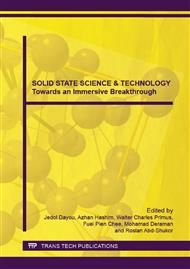[1]
F.M. Gray, Polymer Electrolytes, The Royal Society of Chemistry, Cambridge, (1997).
Google Scholar
[2]
J.E. Weston, B.C.H. Steele, Solid State Ionics 7 (1987) 75-79.
Google Scholar
[3]
Z. Whang, B. Huang, H. Huang, L. Chen, R. Xue, F. Wang, Solid State Ionics 85 (1996) 143-148.
Google Scholar
[4]
S.R. Starkey, R. Frech, Electrochimica Acta 42 (93) (1997) 471-474.
Google Scholar
[5]
R.H.Y. Subban, A.K. Arof, European Polymer Journal 40 (2004) 1841-1847.
Google Scholar
[6]
N. Srivastava, S. Chandra, European Polymer Journal 36 (2000) 421-423.
Google Scholar
[7]
H. Cheng, C. Zhu, B. Huang, M. Lu, Y. Yang, Electrochimica Acta 52 (2007) 5789–5794.
Google Scholar
[8]
S.F. Mohammad, N. Zainal, S. Ibrahim, N.S. Mohamed, Int. J. of Electrochem. Sci. 8 (2013) 6145-6153.
Google Scholar
[9]
N. Khairul Anwar, R.H.Y. Subban, N. S. Mohamed, Materials 5 (2012) 2609-2620.
Google Scholar
[10]
H.P. S. Missan, B.S. Lalia, K. Karan, A. Maxwell, Materials Science and Engineering B 175 (2010) 143-149.
Google Scholar
[11]
P.K. Singh, K.W. Kim, H. W Rhee, Synthetic Metals 159 (2009) 1538-1541.
Google Scholar
[12]
D. Kumar, S.A. Hashmi, Solid State Ionics 181 (2010) 416-423.
Google Scholar
[13]
A.S. Fischer, M.B. Khalid, M. Widstrom, P. Kofinas, Journal of Power Sources 196 (2011) 9767-9773.
Google Scholar
[14]
J.H. Shin, W.A. Henderson, S.S.P.P. Prosini, S. Passerini, Journal of Power Sources 156 (2006) 560-566.
Google Scholar
[15]
A.M. Smith, K.R.J. Lovelock, N.N. Gotsvani, P. Licence, A. Dolan, T. Welton, S. Perkin, The Journal of Physical Chemistry Letters 4 (2013) 378-382.
Google Scholar
[16]
A.L. Saroj, R.K. Singh, S. Chandra, Materials Science and Engineering B 178 (2013) : 231-238.
Google Scholar
[17]
S. Kim, S.J. Park, Electrochimica Acta 54 (2009) 3775-3780.
Google Scholar
[18]
W. Huang, R. Frech, Polymer 35(20) ( 1994) 235-242.
Google Scholar
[19]
L.C. Wen, Ph. d Thesis, Investigation on lithium ion conductivity and characterization of PMMA–PVC based polymer electrolytes incorporating ionic liquid and nano-filler, Universiti Tunku Abdul Rahman, 2011, pp.228-237.
Google Scholar
[20]
R. Baskaran, S. Selvasekarapandian, N. Kuwata, J. Kawamura & T. Hattori, Solid State Ionics 177 (2006) 2679–2682.
DOI: 10.1016/j.ssi.2006.04.013
Google Scholar


